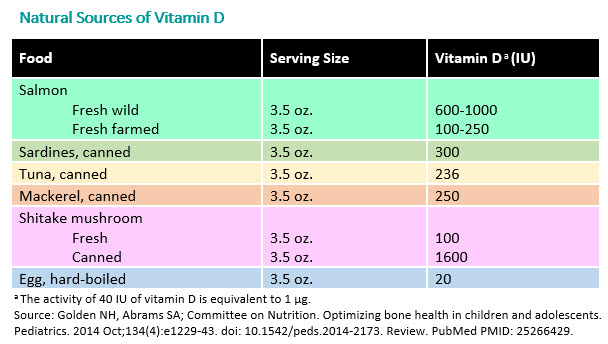Vitamin D and Calcium in Children
Four Seasons Pediatrics is on Twitter. @fspeds
Common wisdom says that if you’re child drinks milk and plays outside, he’s getting enough vitamin D, right? Surprisingly, not necessarily. We know more about vitamin D than we did even five years ago. Because of lifestyle changes and sunscreen usage, the majority of the population shows signs of vitamin D deficiency. Vitamin D helps ensure the body absorbs and retains calcium and phosphorus, both critical for building bone. A vitamin D deficiency can lead to rickets, a bone-softening disease that continues to be reported in the United States mostly in children in the first two years of life. Vitamin D deficiency also increases the risk of bone fractures in older children, teens, and adults. Vitamin D is measured in International Units (IU).
The increase in the recommended amount of vitamin D children need each day is a result of new evidence showing its life-long health benefits. Supplementation is important, because most children will not get enough vitamin D through diet alone.
For a list of foods with vitamin D, click here. See the products for supplementing Vitamin D below – along with the links posted.
What are the current recommendations for Vitamin D?
1. Breastfed infants and partially breastfed infants should be supplemented with 400 IU/day of Vitamin D until your infant is weaned to at least 18-20 ounces of vitamin fortified formula. Supplement with 400 IU when switching to milk at 12 months of age. When switching to milk, we no longer recommend switching to whole milk. All children should be on nonfat milk at age 2, and most should be on nonfat milk starting at age 1 when they switch. The amount of Vitamin D is the same in all types of milk. Higher fat does not confer advantages, in fact there are disadvantages.
2. Older children (older than 12 months of age should receive 400-600 IU per day of vitamin D.
3. Adolescents who do not obtain 600 IU of vitamin D per day through diet and vitamin D fortified foods (such as cereal and eggs) should receive a vitamin D supplement of 600 IU per day.
Here are some of the choices to supplement Vitamin D:
- Enfamil D Vi Sol – vitamins – contains vitamin D. Contains 50 doses. 1 ml contains 400 IU of vitamin D
- Bio-D Mulsion – 1 drop contains 400 IU of vitamin D. Contains 750 doses. Just be careful using, there is a risk of incorrect dosing since this is very concentrated. It is also inexpensive
- Vitamin D chewables – 1 gummi contains 600 IU
- Vitamin D capsules – 600 IU per capsule

What are the current recommendations for calcium?
How much calcium your body needs varies according to age. You need the most calcium between 9 and 18 years of age.
The American Academy of Pediatrics recommends the following daily intake of calcium:
| Age | Calcium Need (mg per day) | Servings of Milk to Meet Need |
| 4–8 years | 800 | 3 servings |
| 9–18 years | 1,300 | 4 servings |
| 9–50 years | 1,000 | 3–4 servings |
How to get calcium
The best way to get the calcium that you need is by eating and drinking foods that naturally contain calcium. Many foods contain some calcium, but the best sources include the following:
-
Low-fat milk, yogurt, and other milk products are generally super sources of calcium.
-
Flavored milks, such as chocolate or strawberry, have as much calcium as plain milk but may have more calories.
-
Dark green, leafy vegetables such as kale and turnip greens are low in calories and high in calcium. However, spinach is not a good source of calcium.
-
Broccoli, tofu, chickpeas, lentils, split peas, and canned salmon and sardines (and other fish with bones) also are good sources of calcium.
-
Calcium-fortified juices and cereals can help boost the calcium in your diet, but limit yourself to 8 to 12 ounces (1½ cups) of juice a day.
What decreases calcium
The following can hurt your bone health:
-
Drinking a lot of soda (pop or soft drinks)—Studies show that this may make you more prone to bone fractures. This may be because sodas often take the place of milk or other calcium-rich drinks. Cola-type sodas also contain phosphorus, which may interfere with how your body handles calcium.
-
Certain diets—Some diets may not provide enough calcium, such as a vegetarian diet that excludes dairy products. Before you start any diet, check with your pediatrician to make sure it includes enough calcium.
-
Caffeine, alcohol, and tobacco—All of these can cause you to lose calcium from your bones.
-
Certain medicines and diseases—Some medicines and kidney and intestinal diseases can cause you to lose calcium from your bones. Ask your pediatrician if any of the medicine you are taking affects your bones and what you can do to protect them.
How to get more calcium
There are many ways to get more calcium, such as
-
Choose milk or smoothies instead of soda at restaurants or school cafeterias.
-
Boost the calcium in salads with beans (such as garbanzo or kidney), cheese, broccoli, almonds, or tofu.
-
Choose yogurt as a light meal or snack.
-
Create special drinks with milk. Add flavorings. Make shakes or smoothies.
-
Use low-fat yogurt on its own or with fresh fruit. Add it to pancakes or waffles, shakes, salad dressings, dips, and sauces.
-
Try calcium-rich foods that may be new to you and your family.
-
Try calcium-fortified juice and calcium-fortified waffles or cereal for breakfast.
-
When possible, choose sources of calcium that are either low in fat or have no fat at all.
-
Or make trade-offs in your food choices. For example, if you go for a thick, chocolate milk shake, skip the French fries. (Removing fat from a food does not take away calcium.)
If you make the right choices, the foods you eat or the things you drink can provide the calcium you need.
Calcium Content of Foods:
| Food | Amount | Calcium (mg) |
| Milk (skim, low fat, whole) | 1 cup | 300 |
| Buttermilk | 1 cup | 300 |
| Cottage Cheese | .5 cup | 65 |
| Ice Cream or Ice Milk | .5 cup | 100 |
| Sour Cream, cultured | 1 cup | 250 |
| Soy Milk, calcium fortified | 1 cup | 200 to 400 |
| Yogurt | 1 cup | 450 |
| Yogurt drink | 12 oz | 300 |
| Carnation Instant Breakfast | 1 packet | 250 |
| Hot Cocoa, calcium fortified | 1 packet | 320 |
| Nonfat dry milk powder | 5 Tbsp | 300 |
| Brie Cheese | 1 oz | 50 |
| Hard Cheese (cheddar, jack) | 1 oz | 200 |
| Mozzarella | 1 oz | 200 |
| Parmesan Cheese | 1 Tbsp | 70 |
| Swiss or Gruyere | 1 oz | 270 |
Vegetables
| Acorn squash, cooked | 1 cup | 90 |
| Arugula, raw | 1 cup | 125 |
| Bok Choy, raw | 1 cup | 40 |
| Broccoli, cooked | 1 cup | 180 |
| Chard or Okra, cooked | 1 cup | 100 |
| Chicory (curly endive), raw | 1 cup | 40 |
| Collard greens | 1 cup | 50 |
| Corn, brine packed | 1 cup | 10 |
| Dandelion greens, raw | 1 cup | 80 |
| Kale, raw | 1 cup | 55 |
| Kelp or Kombe | 1 cup | 60 |
| Mustard greens | 1 cup | 40 |
| Spinach, cooked | 1 cup | 240 |
| Turnip greens, raw | 1 cup | 80 |
Fruits
| Figs, dried, uncooked | 1 cup | 300 |
| Kiwi, raw | 1 cup | 50 |
| Orange juice, calcium fortified | 8 oz | 300 |
| Orange juice, from concentrate | 1 cup | 20 |
Legumes
| Garbanzo Beans, cooked | 1 cup | 80 |
| Legumes, general, cooked | .5 cup | 15 to 50 |
| Pinto Beans, cooked | 1 cup | 75 |
| Soybeans, boiled | .5 cup | 100 |
| Temphe | .5 cup | 75 |
| Tofu, firm, calcium set | 4 oz | 250 to 750 |
| Tofu, soft regular | 4 oz | 120 to 390 |
| White Beans, cooked | .5 cup | 70 |
Grains
| Cereals (calcium fortified) | .5 to 1 cup | 250 to 1000 |
| Amaranth, cooked | .5 cup | 135 |
| Bread, calcium fortified | 1 slice | 150 to 200 |
| Brown rice, long grain, raw | 1 cup | 50 |
| Oatmeal, instant | 1 package | 100 to 150 |
| Tortillas, corn | 2 | 85 |
Nuts and Seeds
| Almonds, toasted unblanched | 1 oz | 80 |
| Sesame seeds, whole roasted | 1 oz | 280 |
| Sesame tahini | 1 oz (2 Tbsp) | 130 |
| Sunflower seeds, dried | 1 oz | 50 |
Fish
| Mackerel, canned | 3 oz | 250 |
| Salmon, canned, with bones | 3 oz | 170 to 210 |
| Sardines | 3 oz | 370 |
Other
| Molasses, blackstrap | 1 Tbsp | 135 |
 Print
Read Past Newsletters
Print
Read Past Newsletters










